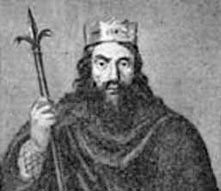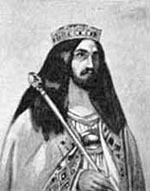|


from
CrystalLinks
The Merovingian
Dynasty was a
Frankish dynasty considered the first French royal house.
It was the first major political authority which rose out of the
ashes of the dying Roman Empire in Europe. It was
named for Merovech (fl. c. 450), whose son Childeric I
(d. 482?) ruled a tribe of Salian Franks from his
capital at Tournai. His son,
Clovis I, united nearly all of Gaul in the late 5th century
except Burgundy and present-day Provence. On his death the realm was
divided among his sons, but by 558 it was united under his last
surviving son, Chlotar I. The pattern of dividing and then
reuniting the realm continued for generations. After the reign of
Dagobert I (623?639), the authority of the Merovingian
kings declined, and real power gradually came to rest in the
hands of the mayors of the palace. In 751 the last Merovingian king,
Childeric III, was deposed by Pippin III, the first of
the
Carolingian dynasty.
Encyclopedia Britannica
|
Clovis I was the first important ruler of the Merovingian
Dynasty and is considered the founder of the French State.
He became Chieftain of the Salian Franks in 481. In 486, he
defeated the last great Roman army in Gaul and went on to defeat
many minor princes, kings and tribal chieftains to form the
first Frankish Kingdom.
Clovis I married in 493 to Clotilda (475 - 545),
later St. Clotilda, daughter of
Childperic, King of the Burgundians. |

Clovis I |
The Merovingian Kings
The Frankish Kingdom was split up among Clovis' sons, and was
temporarily united several times during the next two centuries when
a single heir survived; notably during the reigns of Clothaire I,
Clothaire II, Dagobert I and Clovis II.
Life in the Sixth Century
Germanic tribesmen living close to the North Sea tended to have fairly
large timber houses supported by four rows of posts that divided the
house into three rooms. The family lived in the centre room, while a
smaller room on one side was used for storage and a larger room on
the other side was used to house the animals whose body heat helped
warm the living quarters. From this arrangement comes the story that
"the people lived in the barn" or that "the cattle lived in
the house."
Further inland, people tended to inhabit dwellings that were supported
by upright posts but without interior supports. These dwellings
varied in size from 20 feet X 12 feet up to perhaps 25 feet square.
Long, narrow buildings about 12 feet X 25 feet housed the cattle
while smaller structures 12 feet square were used for storage. Some
of these smaller storage buildings were partially underground.
The main crops were barley, wheat, oats, peas and beans. Crop rotation
was practiced, and fields were improved by adding limestone and
manure. Depleted soil was abandoned and new land brought into use
using the slash and burn technique. Simple scratch ploughs pulled by
oxen were most common, and they didn't actually turn the soil. Grain
was left attached to the hay and was roasted slightly to preserve
it. Grain was separated from the hay as needed and ground using
simple hand grindstones. Once ground, flour was used to prepare
porridge and flat bread. Grain was also used to make beer.
Cattle were very important and were an indicator of wealth. Pigs,
sheep, goats, horses, chickens and geese were also kept. Every
portion of the animals was used either for food or for the
production of clothing, shelter and utensils. Wild animals were
hunted and killed for sport and to eliminate nuisance animals. Wild
animals are thought to have made up less than 5% of the total
animals used.
Iron was produced using small, crude but effective charcoal furnaces
made of earth. These ovens held about a liter of ore, and only 200
grams of iron could be made at a time from the very best ore. This
iron was worked into very high quality steel, far superior to the
equipment of the Roman troops. However, the Germanic tribes were
iron poor, and weapons such as long swords were rare.
Each individual household was dominated by the father who held
authority over all the members. A number of households, sometimes as
many as fifty, were grouped into a family clan-like organization. A
number of clans formed a tribe which was sometimes overseen by a
"king" who was really a tribal chieftain. The "king" was usually
chosen from one family that was most closely identified with the
ethnic, cultural and historical traditions of the tribe - that is,
from a "royal family." Some tribes had several kings, one to preside
over meetings, one for religious ceremonies and one for military
command. Other tribes didn't have a king at all.
In order to survive and prosper, a tribe had become almost completely
militarized; that is, the tribe had to become an army. This is what
appears to have happened with the Salian Franks whose
Merovingian Kings dominated the region from the fifth
century onwards.
The Decline of the Merovingian Kings
From the middle of the seventh century on, their power declined and
the real authority rested to an ever increasing extent with the
Mayors of the Palace. The king became a figurehead distinguished by
his beard, long hair, crown and throne. When King Theuderic IV
died in 737, he was not replaced.
Charles Martel ruled instead as Mayor of the Palace.
Charles Martel died in 741 and was succeeded by his sons
Pépin the Short and
Carloman.
The brothers Pépin and Carloman instituted another king, Childeric
III
in 743, largely to ease the concern of other Frankish leaders about
their growing power. Carloman withdrew from politics in 747
and
retired to the monastery of Monte Casino.
|
In 751, Childeric III also wisely decided to retire to a
monastery and
Pépin the Short had himself proclaimed king in November 751,
thus officially ending the Merovingian Dynasty.
Pépin I the Short was the first Carolingian King. Having displaced
the Merovingians, it was in the interests of the
Carolingian Kings to depict their predecessors as
useless anachronisms. Hence, the earlier Merovingians
were depicted as evil and brutal tyrants while later
Merovingians were propagandized as lazy and simple
incompetents. If a Merovingian could be deposed and sent to a
monastery, and a new king consecrated in his place, so too could
a Carolingian. Less than a century later, Louis the Pious
was temporarily displaced; and by the tenth century, the
Carolingians were replaced altogether by the Capetian
Kings.
|

Childeric III the last Merovingian King |
|

